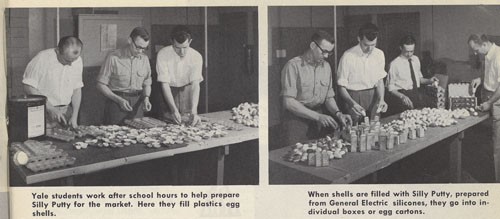Sometimes failed experiments even led to terrific...toys. Silly putty is one example. Silly putty resulted from a mislabeled bottle of what scientists thought was boron nitride at a GE research lab in New Haven, Connecticut. The year was 1943, the middle of World War II, and U.S. private industry had essentially re-configured to support the military, creating new technologies like primitive computers that controlled guns on B-29 bombers, improved marine engines and, by accident, Silly Putty.
GE scientist James Wright and his team were working around the clock to develop new silicone rubbers for the military because there was a shortage of natural rubber; Japan controlled all of the natural sources. They spent over a year experimenting with different combinations of chemical compounds, hoping to produce a synthetic, 'hard rubber' silicone that could withstand the high heat of jet engines or the freezing cold nights on Navy ships. In the summer in 1943, they tried adding boron nitride as filler to an experimental silicone compound but didn't realize the substance they thought was boron nitride was actually a mixture of other chemical compounds, including boric acid. Then they tried adding just boric acid.

1951 edition of GE Adventures Ahead magazine showing Silly Putty. Credit: GEReports.com
It was a failure. The resulting substance was gooey, not hard. Frustrated, Wright threw the goop onto the floor and, to his surprise, it bounced right back up at him. A reporter from the Saturday Evening Post described the scene in a story. “‘Golly,’ the scientist exclaimed as he dropped a ball of silicone putty, ‘look at it bounce!’”
They eventually created the harder form of synthetic rubber, and it did its part in boosting the war effort, but that accidental bouncing putty captured America’s attention and is still known today. Wright and his team, not sure what to do with it, gave it out to local children. In 1944, newspaper reporters, intrigued by stories of 'silly' putty, crashed a GE cocktail party in Manhattan intended to showcase the silicone discovery. According to a “Talk of the Town” piece in The New Yorker:
A couple of morosely sportive photographers began draping a General Electric chemist with strands of bouncing putty. "Cut it out, now, fellows," the chemist said, giggling nervously.By 1950, a New Haven entrepreneur began marketing it as Silly Putty and, to promote it, he hired Yale students to plastic egg shells as packaging and it took off. In 2001, Wright’s wartime lab mishap was inducted into the National Toy Hall of Fame.







Comments